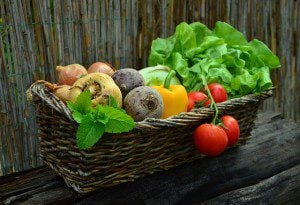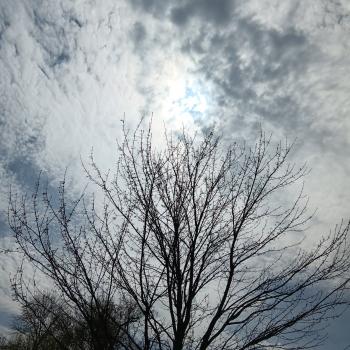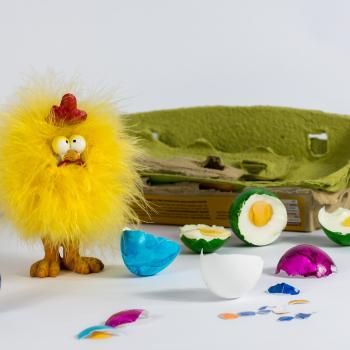
This is my first year to plant potatoes.
“When do they go in the ground?” I asked the lady at the garden shop.
“Around Saint Patrick’s Day,” she said.
I found that oddly appropriate.
In the Ohio Valley, Potatoes go into the ground on Saint Patrick’s day. Onions go in earlier, as soon as you can work the soil; Candlemas is not too early if you can manage. Garlic should be planted with the onions, or plant it during Advent, mulch well and let it overwinter. Green peas should be sown on Saint Joseph’s Day, and corn ten days before the feast of Saint Mark. Never plant tomatoes before Orthodox Easter, and Saint Matthias’s Day is safest if we’ve had a cold year. Gardening is all about timing, as much as it is about anything else. Your timing must be right. Your watering must be neither too generous nor too stingy. You must know which plants flourish in comfort and which need to be treated severely. You must go out in the evening, when frost comes after Orthodox Easter, and place cloches over the tomatoes.
I learned to garden when we were desperately poor– our tumbledown, mold-infested apartment building was built on the side of a hill, and our porch faced the shady slope of a small yard. The landlord didn’t care what we did with it, as long as we left him alone, so Michael and I dug it up with one shovel between us. We boiled and ate all the dandelions and violets we’d dug out of the lawn, because we were too poor to waste food of any kind. We found an old brick patio under what had become the lawn, and we dug up the bricks. I learned to work the soil, to lay down fertilizer, and to make compost. An organic farmer friend gave us some seedlings, and the rest I bought cheap from the grocery store, thinking it would save us money. I planted all the seedlings in one day, the last dry day before a predicted week of rain; I worked as the rain began and grew harder and harder, digging up the patch, breaking up roots and fertilizing until I was caked with mud and dripping sweat, my fingers cramped and sore. I learned the strange exhilaration of peeling off soil-plastered clothing and stepping into a hot bath, scrubbing again and again, watching my skin eventually go back to its usual color, though red with new callouses. I learned what it was to put on clean clothes and sit down to a meal after hours of gardening in ankle-deep mud– a foretaste of Heaven.
Days later, I discovered that the odd pits in the ground at the edge of our yard were groundhog holes, and the beasts had eaten half my seedlings. I begged from gardener friends again and scraped together pocket change. I replaced the plants with vegetables that groundhogs aren’t supposed to like. Some of them were eaten in short order anyway, but some survived. I placed moth balls in the garden and Michael collected urine to sprinkle on the corners of the patch. I poured ammonia down one of the holes to flush the groundhog out the other. I jumped out of my apartment shouting threats at random times every few hours, hoping to scare it away. Michael did surprise it once, chased it back into its hole with the shovel and tried to dig it out. Nothing worked for more than a few days.
Next, the professional lawnmower the landlord had hired weed-whacked a patch of herbs and pulled up some fencing to destroy a few bean plants. There was nothing I could do to stop him, as the landlord didn’t care. I would go outside and stand helplessly on the porch when I heard the mower, hoping my presence would inspire him to do no more damage. Then potato bugs came out of the brush and attacked my eggplants. I picked them off by hand. Then the cheap grocery store seedlings bolted with no explanation; cheap grocery store seedlings are never worth the money saved. The pumpkins were attacked by a plague of worms, and I went out to stack them on boards, hoping that keeping them off of the soil would help stop the rot.
When it came time to harvest, we collected very little. Enough to cover what little we’d invested at the grocery store garden department, but not much more. A basket of tomatoes. A few stir-frys worth of green beans. Two leprous pumpkins. Nothing to put away for winter.
The next year, we were able to leave the horrible apartment building and move into a rental house. The house had a sunny yard with no groundhogs, no buried bricks and no spiteful lawn mowing service. I dug up a small stretch for a garden. I used all the techniques I had learned in the shady yard– I fertilized carefully. I watered as needed and not too much. I paid the extra few dollars for strong seedlings from the garden store. I planted tomatoes, zucchini, broccoli and beans. I looked out for groundhogs and potato bugs, but there were none.
The harvest was enormous. Tomatoes enough to make sauce, tomatoes forgotten and rotting on the kitchen windowsill, zucchini as thick as my arms, baby eggplant almost every day, broccoli my daughter picked raw and ate like an apple. More produce than we knew what to do with. We gave away vegetables to the neighbor children; one little boy had never heard of eggplant before, but he enjoyed it that night. A happy ending. A happy beginning, because there is still parboiled zucchini in my freezer and I’m digging two large patches for this year’s garden. Potatoes, tomatoes, onions, beans, green peas, corn, two kinds of squash, anything I can cram into the yard. We’ll feed all the neighbors and anyone who comes to us.
It’s like a sermon a saint would preach, and if only I were a saint I would preach it.
(Image via pixabay)

















